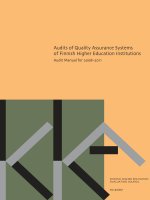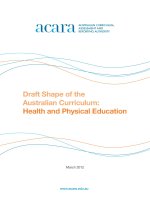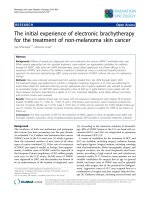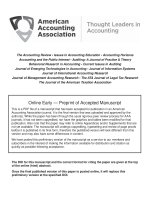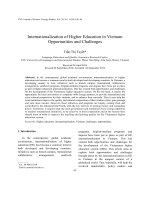The Australian experience of internationalizing higher education
Bạn đang xem bản rút gọn của tài liệu. Xem và tải ngay bản đầy đủ của tài liệu tại đây (2.12 MB, 54 trang )
The Australian experience of
internationalizing higher education
V. Lynn Meek
LH Martin Institute for Higher Education Leadership and Management
University of Melbourne
OCUFA Conference: “The Race to Globalize Higher Education in
Canada” January 21-22, 2011
Sutton Place Hotel, Toronto
www.lhmartininstitute.edu.au
1
Outline
Australian education context and system overview
Policy context of internationalization
Size and shape of internationalization of HE
International education as a business
Current challenges
Conclusion
2
AUSTRALIA IN CONTEXT
3
Effigies of leaders attending 2010 G20 Summit in
Seoul – Julia Gillard portrayed as Austrian dairy
maid
4
AUSTRALIA
IN CONTEXT:
How big?
5
Source: />
AUSTRALIA
IN CONTEXT:
Population distribution
Population about
22 million
1% of the continent contains
84% of the population
Source: />%40.nsf/95553f4ed9b60a374a2568030012e707/fe3fa39a5bf5aa5aca256b350010b3fd/Body/0.59E!
6
AUSTRALIA
IN CONTEXT:
Global trends
• In 2008, 3.3m tertiary students enrolled outside country of
citizenship – of whom 79.1% studying in OECD countries
• Growth accelerated over last decade with an average annual
increase of 9%
• Australia, France, Germany, the UK and USA enroll more than
50% of all foreign students
• Largest numbers from China and India, globally and for
Australia
7
International students in Australia: Top 10 source
countries
Nationality
Numbers 2009
% 2009
China
156,127
25%
India
120,144
19%
South Korea
35,620
6%
Thailand
26,366
4%
Nepal
24,534
4%
Vietnam
23,678
4%
Malaysia
23,112
4%
Indonesia
23,112
4%
Brazil
17,510
3%
Saudi Arabia
12,439
2%
Other
172,352
27%
Total
629,684
100%
8
Distribution of international students by
country of destination, 2008
OECD 2010: 314
9
Percentage of international
students in tertiary enrolments,
2008
OECD 2010: 310
10
The Australian tertiary
education system
• 37 large to very large public universities; 2 small private
universities
• About 150 non-university private providers of higher education
• University governance: autonomous, self-accrediting institutions
established by act of State parliament, governed by lay council
• Federation of 6 States and 2 territories, but public universities
primarily funded and regulated by the federal government
• Large Vocational Education & Training (VET) sector consisting of
public and private institutions, controlled primarily by State
governments, with about 1.6m mostly sub-degree students and
enrolling about 231,000 international students
• In 2009, 1,134,866 higher education students, of whom 813,896
were domestic (72%) and 320,970 (28%) International (studying onshore and off-shore)
11
The higher education
policy context:
The rise and fall (?)/success and failure(?)
of Australian international education is a
product of two decades of reform of higher
education based on market, neo-liberal
principles
Sustained growth of international
education born from financial necessity,
but has assumed a life of its own
12
Back to the future: the Dawkins
reforms (1987-1996)
•
•
•
Creation of the UNS
Shift of cost from State to Individual - HECS
Enhanced competition for students and research income RQ
•
Emphasis on accountability for the government dollar
•
Deregulation within the higher education sector
•
Reliance on income gained from sources other than the
Commonwealth
•
Application of New Public Management principles to higher
education
•
Increased emphasis on demonstrable contribution to
economy of the nation
13
The Howard reforms: from
pragmatism to ideology (19962007)
• Reduction of operating grants by 5 per cent
• Increase in level of HECS (domestic tuition
fees) payments
• No Commonwealth supplementation of
funding per student place (other for inflation)
• Continued emphasis on management
efficiency and NPM values in higher education
• Decade of public funding stagnation - higher
education cost rather than investment
14
Gillard Labor Government
reforms: “The Education
Revolution” (2007 - )
• Too early to tell
15
Total Australian government higher
education funding, 1989 - 2010
DEEWR 2010: 29
16
University income per government
supported student place, 1989 - 2010
DEEWR 2010:30
17
Percentage change in real expenditure on
tertiary education institutions, selected
OECD countries, 1995 to 2005
18
Bradley 2008
Total higher education revenue by
source, 2009
DEEWR 2010: 36
19
Total higher education revenue by
source, 1995 - 2009
DEEWR 2010: 40
20
Internationalization policy context:
from aid to trade
21
From Aid to Trade
• Pre 1990 reforms: education of foreign students subsidised by government
aid programs; fees not paid directly to institutions
Colombo Plan (1951 – 1982) government funded scholarships for students
from Asia Pacific countries to study at Australian universities
1980 – introduction of system of foreign student tuition visa fees (Overseas
Student Charge (OSC)), collected by government not by universities
Over the decade, OSC increased to 45% of full average course cost, thus
substantial but not full subsidisation continued
Growing demographic and budget pressure on institutions, political issue of
subsidising overseas students and economic strains on Australian
economy lead to two major Parliamentary Reviews:
Goldring Review of Private Overseas Student Policy
Jackson Review of the Australian Overseas Aid Program
22
From Aid to Trade
• 1986, government accepts Jackson recommendations for unrestricted
entry of overseas students on a full cost recovery basis
• 1988, announcement that subisdised program phased out by 1992
• Post 1990, all foreign students enter Australian universities on a full cost
basis - government deregulated the overseas student market by allowing
individual institutions to directly recruit overseas students and to set and
retain fees with no corresponding reduction in government operating
grants. The change in policy was justified in the following terms:
“In the light of significant external economic changes and changes in the
policy and administrative environment, Australia could no longer see
itself so much as a donor of education and training services to
developing countries, a benefactor, but more as a partner where mutual
benefits for individuals and countries is the desired outcome” (DEET
1991: 380).
23
Size and shape of internationalization of higher
education: how has Australia performed?
• Nearly two and a half million international students have
studied in Australian schools, universities and other
institutions since records were first kept.
• The number of international students onshore in Australia grew
from 21,118 in 1988 to 629,864 in 2009
24
Its unstoppable
25

